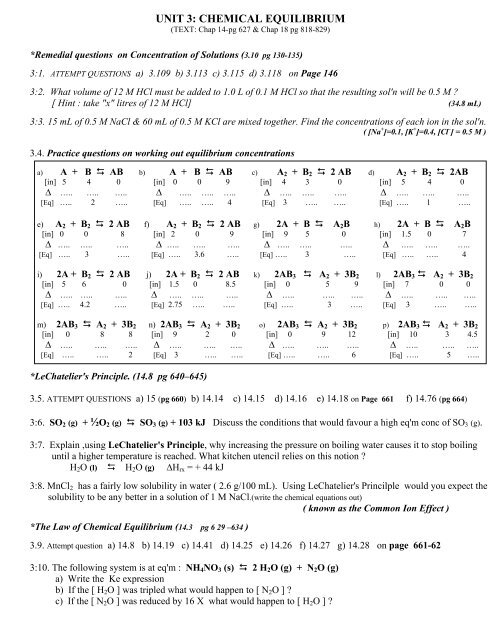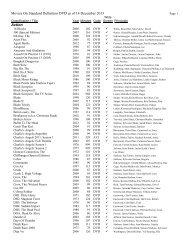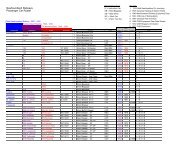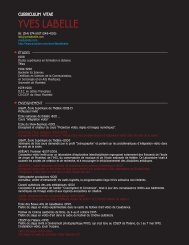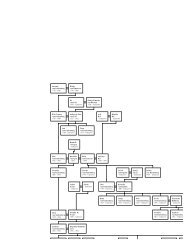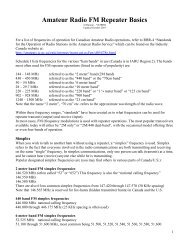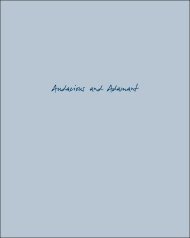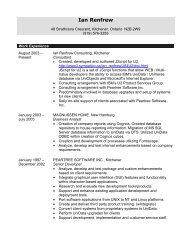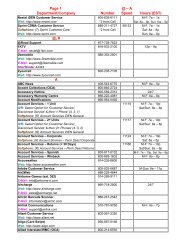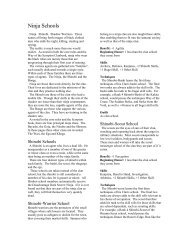UNIT 3: CHEMICAL EQUILIBRIUM - Sympatico
UNIT 3: CHEMICAL EQUILIBRIUM - Sympatico
UNIT 3: CHEMICAL EQUILIBRIUM - Sympatico
You also want an ePaper? Increase the reach of your titles
YUMPU automatically turns print PDFs into web optimized ePapers that Google loves.
<strong>UNIT</strong> 3: <strong>CHEMICAL</strong> <strong>EQUILIBRIUM</strong>(TEXT: Chap 14-pg 627 & Chap 18 pg 818-829)*Remedial questions on Concentration of Solutions (3.10 pg 130-135)3:1. ATTEMPT QUESTIONS a) 3.109 b) 3.113 c) 3.115 d) 3.118 on Page 1463:2. What volume of 12 M HCl must be added to 1.0 L of 0.1 M HCl so that the resulting sol'n will be 0.5 M ?[ Hint : take "x" litres of 12 M HCl] (34.8 mL)3:3. 15 mL of 0.5 M NaCl & 60 mL of 0.5 M KCl are mixed together. Find the concentrations of each ion in the sol'n.( [Na + ]=0.1, [K + ]=0.4, [Cl – ] = 0.5 M )3.4. Practice questions on working out equilibrium concentrationsa) A + B AB b) A + B AB c) A 2 + B 2 2 AB d) A 2 + B 2 2AB[in] 5 4 0 [in] 0 0 9 [in] 4 3 0 [in] 5 4 0∆ ….. ….. ….. ∆ ….. ….. ….. ∆ ….. ….. ….. ∆ ….. ….. …..[Eq] ….. 2 ….. [Eq] ….. ….. 4 [Eq] 3 ….. ….. [Eq] ….. 1 …..e) A 2 + B 2 2 AB f) A 2 + B 2 2 AB g) 2A + B A 2 B h) 2A + B A 2 B[in] 0 0 8 [in] 2 0 9 [in] 9 5 0 [in] 1.5 0 7∆ ….. ….. ….. ∆ ….. ….. ….. ∆ ….. ….. ….. ∆ ….. ….. …..[Eq] ….. 3 ….. [Eq] ….. 3.6 ….. [Eq] ….. 3 ….. [Eq] ….. ….. 4i) 2A + B 2 2 AB j) 2A + B 2 2 AB k) 2AB 3 A 2 + 3B 2 l) 2AB 3 A 2 + 3B 2[in] 5 6 0 [in] 1.5 0 8.5 [in] 0 5 9 [in] 7 0 0∆ ….. ….. ….. ∆ ….. ….. ….. ∆ ….. ….. ….. ∆ ….. ….. …..[Eq] ….. 4.2 ….. [Eq] 2.75 ….. ….. [Eq] ….. 3 ….. [Eq] 3 ….. …..m) 2AB 3 A 2 + 3B 2 n) 2AB 3 A 2 + 3B 2 o) 2AB 3 A 2 + 3B 2 p) 2AB 3 A 2 + 3B 2[in] 0 8 8 [in] 9 2 0 [in] 0 9 12 [in] 10 3 4.5∆ ….. ….. ….. ∆ ….. ….. ….. ∆ ….. ….. ….. ∆ ….. ….. …..[Eq] ….. ….. 2 [Eq] 3 ….. ….. [Eq] ….. ….. 6 [Eq] ….. 5 …..*LeChatelier's Principle. (14.8 pg 640–645)3.5. ATTEMPT QUESTIONS a) 15 (pg 660) b) 14.14 c) 14.15 d) 14.16 e) 14.18 on Page 661 f) 14.76 (pg 664)3:6. SO 2 (g) + ½O 2 (g) SO 3 (g) + 103 kJ Discuss the conditions that would favour a high eq'm conc of SO 3 (g).3:7. Explain ,using LeChatelier's Principle, why increasing the pressure on boiling water causes it to stop boilinguntil a higher temperature is reached. What kitchen utencil relies on this notion ?H 2 O (l) H 2 O (g) ∆H rx = + 44 kJ3:8. MnCl 2 has a fairly low solubility in water ( 2.6 g/100 mL). Using LeChatelier's Princilple would you expect thesolubility to be any better in a solution of 1 M NaCl.(write the chemical equations out)( known as the Common Ion Effect )*The Law of Chemical Equilibrium (14.3 pg 6 29 –634 )3.9. Attempt question a) 14.8 b) 14.19 c) 14.41 d) 14.25 e) 14.26 f) 14.27 g) 14.28 on page 661-623:10. The following system is at eq'm : NH 4 NO 3 (s) 2 H 2 O (g) + N 2 O (g)a) Write the Ke expressionb) If the [ H 2 O ] was tripled what would happen to [ N 2 O ] ?c) If the [ N 2 O ] was reduced by 16 X what would happen to [ H 2 O ] ?
*Calculating the equilibrium constant ( Ke or Kc) (14.9 pg 6 45 - 649 )3.11. Attempt questions a) 14.49 b) 14.50 c) 14.45 d) 14.46 e) 14.48 on page 663 in your text3:12. Consider this eq'm : PCl 5 (g) + H 2 (g) 2 HCl (g) + PCl 3 (g) in a 2 L vessel, at eq'm, there were 2 molof PCl 5 (g) , 2 mol of H 2 (g) ,6 mol of HCl and 2 mol of PCl 3 (g)a) Calculate Ke for this rx. b) Calculate Ke for the reverse rx.3:13. A rx'n occurs according to this equation : A (g) + 2 B (g) 2 C (g)* 3 mol of A and 5 mol of B are reacted in a 3 L container. After equilibrium had been reached 1 mol of Aremained in the container. Calculate Ke for the rx.3:14. Attempt questions a) 14.51 b) 14.52 c) 14.53 d) 14.54 on page 663*Using the equilibrium constant ( Ke or Kc) to calculate eq’m concentrations (14.9 pg 6 49-655 )3:15. Given : Pb 2+ (aq) + Sn (s) Sn 2+ (aq) + Pb (s) ; Ke = 1.2* If 0.1 mol of lead nitrate is dissolved in 200 mL of water and a chunk of solid tin added, find the eq'mconcentrations of both metallic ions.3:16. Attempt questions a) 14.55 b) 14.57 c) 14.59 on page 663 ( all perfect squares)3:17. For the reaction : CO 2 (g) + H 2 (g) CO (g) + H 2 O (g) Ke = 0.02Suppose that 22 g of CO 2 and 2 g of H 2 are placed in a 2.0 L container. Find the eq'm concentrations of allspecies and plot a rough conc - time graph.3:18. Attempt questions a) 14.66 b) 14.68 on page 664 ( use the quadratic eq’n)3:19. The following system was allowed to reach eq'm :SO 3 (g) + NO (g) NO 2 (g) + SO 2 (g) The 1st eq'm concentrationswere : [NO 2 ] eq’m = 0.8 M , [SO 2 ] = 0.12 M, [NO] = 0.4 M, & [SO 3 ] = 0.48 M* NOW an additional 0.52 M SO 3 was added to the system, determine the 2nd eq'm concentrations of allspecies at this new eq'm state and plot a rough conc - time graph.*Free Energy ( ∆G ) and Equilibrium (18.8 pg 818)3.20. Attempt questions a) 18.90 b) 18.91 c) 18.93 d) 18.89 on page 840 in your text3:21. Using your data sheet calculate ∆G and then Ke for the reaction2 NO (g) + 2 CO (g) N 2 (g) + 2 CO 2 (g) at 500°C.3:22. Consider this reaction : CO (g) + 1/2 O 2 (g) CO 2 (g)a) Calculate ∆G and Ke for the rx at 300 °Cb) Calculate the temp at which ∆G =0. What is Ke at this temp ?c) Discuss the temp range of spontaneity for the rx
Chemical Equilibrium: Finding a Constant, Ke ( Kc )The purpose of this lab is to experimentally determine the equilibrium constant, Kc, for the following chemical reaction:Fe 3+ aq) + SCN - (aq) FeSCN 2+ (aq)iron(III) thiocyanate ferrocyanate ionWhen Fe 3+ and SCN- are combined, equilibrium is established between these two ions and the FeSCN2+ ion. In order tocalculate Kc for the reaction, it is necessary to know the concentrations of all ions at equilibrium: [FeSCN 2+ ]eq, [SCN - ]eq,and [Fe 3+ ]eq. You will prepare four equilibrium systems containing different concentrations of these three ions. Theequilibrium concentrations of the three ions will then be experimentally determined. These values will be substituted into theequilibrium constant expression to see if Kc is indeed constant.In order to determine [FeSCN 2+ ] eq , you will use the colorimeter shown in Figure 1. The FeSCN 2+ ion produces solutions witha red color. Because the red solutions absorb blue light very well, the blue LED setting on the colorimeter is used. Thecomputer-interfaced colorimeter measures the amount of blue light absorbed by the colored solutions (absorbance, A). Bycomparing the absorbance of each equilibrium system, Aeq, to the absorbance of a standard solution, Astd, you candetermine [FeSCN 2+ ]eq. The standard solution has a known FeSCN 2+ concentration.To prepare the standard solution, a very large concentration of Fe 3+ will be added toa small initial concentration of SCN - (hereafter referred to as [SCN - ]i. The [Fe 3+ ] inthe standard solution is 100 times larger than [Fe 3+ ] in the equilibrium mixtures.According to LeChatelier's principle, this high concentration forces the reaction farto the right, using up nearly 100% of the SCN - ions. According to the balancedequation, for every one mole of SCN - reacted, one mole of FeSCN 2+ is produced. Thus [FeSCN 2+ ]std is assumed to be equalto [SCN - ]i.Assuming [FeSCN 2+ ] and absorbance are related directly (Beer's Law), the concentration of FeSCN 2+ for any of theequilibrium systems can be found by:[FeSCN 2+ ]eq = A eqAstd X [FeSCN2+ ]stdKnowing the [FeSCN 2+ ] eq allows you to determine the concentrations of the other two ions at equilibrium. Foreach mole of FeSCN 2+ ions produced, one less mole of Fe 3+ ions will be found in the solution (see the 1:1 ratio ofcoefficients in the equation on the previous page). The [Fe 3+ ] can be determined by:[Fe 3+ ]eq = [Fe 3+ ]i – [FeSCN 2+ ]eqBecause one mole of SCN - is used up for each mole of FeSCN 2+ ions produced, [SCN - ] eq can be determined by:[SCN - ]eq = [SCN - ]i – [FeSCN 2+ ]eqKnowing the values of [Fe 3+ ] eq , [SCN - ] eq , and [FeSCN 2+ ] eq , you can now calculate the value of K c , theequilibrium constant.PROCEDURE1. Pipet 5.0 mL of 0.0020 M Fe(NO 3 ) 3 into each of 4 labeled test tubes. CAUTION: Fe(NO 3 ) 3 solutions inthis experiment are prepared in 1.0 M HNO 3 and should be handled with care.2. Pipet 2, 3, 4 and 5 mL of 0.0020 M KSCN into tubes 1-4, respectively. Then pipet 3, 2, 1 and 0 mL ofdistilled water into tubes 1-4, respectively, to bring the total volume of each test tube to 10 mL. Mix eachsolution thoroughly with a stirring rod. Be sure to clean and dry the stirring rod after each mixing. Measureand record the temperature of one of the above solutions to use as the temperature for the equilibriumconstant, Kc. Volumes added to each test tube are summarized below:Test Tube Number Fe(NO 3 ) 3 (mL) KSCN (mL) H 2 O (mL)1 5 2 32 5 3 23 5 4 14 5 5 02. Prepare a standard solution of FeSCN 2+ by pipetting 18 mL of 0.200 M Fe(NO 3 ) 3 into a test tube labeled “5”.Pipet 2 mL of 0.0020 M KSCN into the tube. Stir thoroughly.
DATA and CALCULATIONS ( show all your work in the space provided)AbsorbanceTrial 1______________Trial 2____________Trial 3____________Trial 4___________Absorbance of standard (Trial 5)_______Temperature_______ °CK c expression K c =[Fe 3+ ] i[SCN - ] i[FeSCN 2+ ] eq[Fe 3+ ] eq[SCN - ] eqK c valueAverage of K c valuesK c = __________________ at ____________°C
Assignment:<strong>EQUILIBRIUM</strong>(1)1.For the system 2 SO 2 (g) + O 2 (g) 2 SO 3 (g)∆ H is negative for the production of SO 3Assume that one has an equilibrium mixture ofthese substances. Predict the effect of each ofthe following changes on the number of molesof SO 3 and on the value of the equilibriumconstant. Briefly account for each of yourpredictions.(a) Decreasing the volume of the system.(b) Adding oxygen to the equilibrium mixture.(c) Raising the temperature of the system.2. Sulfuryl chloride, SO 2 Cl 2 , is a highly reactivegaseous compound. When heated, it decomposes asfollows: SO 2 Cl 2 (g) SO 2 (g) + Cl 2 (g).This decomposition is endothermic.A sample of 3.509 grams of SO 2 Cl 2 is placed in anevacuated 1.00 litre bulb and the temperature israised to 375K.(a) What would be the pressure of this gas (in kPa) inthe bulb if no dissociation of the SO 2 Cl 2 (g)occurred? (use PV=nRT)(b) When the system has come to equilibrium at 375K,the total pressure in the bulb (the sum of all thepartial pressures of all the gases present) is foundto be 145 kPa.Calculate the partial pressures of SO 2 , Cl 2 , andSO 2 Cl 2 at equilibrium at 375K. (recall DaltonsLaw of partial pressures)(c) Write the equilibrium constant expression for thedecomposition of SO 2 Cl 2 (g) at 375K.Calculate the value of the equilibrium constant(K P ) for this rx.(d) If the temperature were raised to 500K, what effectwould this have on the equilibrium constant?Explain briefly.3. CO 2 (g) + H 2 (g) H 2 O (g) + CO (g)When H 2 (g) is mixed with CO 2 (g) at 2000 K,equilibrium is achieved according to the equationabove. In one experiment, the followingequilibrium concentrations were measured.[H 2 ] = 0.20 mol/L[CO 2 ]= 0.30 mol/L[H 2 O] = [CO] = 0.55 mol/L(a) Using the equilibrium concentrations given,calculate the value of K e for the reaction.(b) When the system is cooled from 2000 K to alower temperature, 30.0 percent of the CO(g) isconverted back to CO 2 (g).Calculate the value of K e at this lowertemperature.(c) In a different experiment, 0.50 mole of H 2 (g) ismixed with 0.50 mole of CO 2 (g) in a 3.0-literreaction vessel at 2000 K. Calculate theequilibrium concentration, in moles per liter, ofCO(g) at this temperature.4. a) Do question 14.78 on page 665b) Draw a rough conc vs time graph to representthe changes that took place in this question.5. NO (g) + 1/2 O 2 (g) NO 2 (g)a) Calculate ∆ G and Ke for this reaction @ 200° Cb) Calculate the temperature at which ∆ G=0 orKe=1 and comment on the spontaneity of thisreaction and its temperature range


